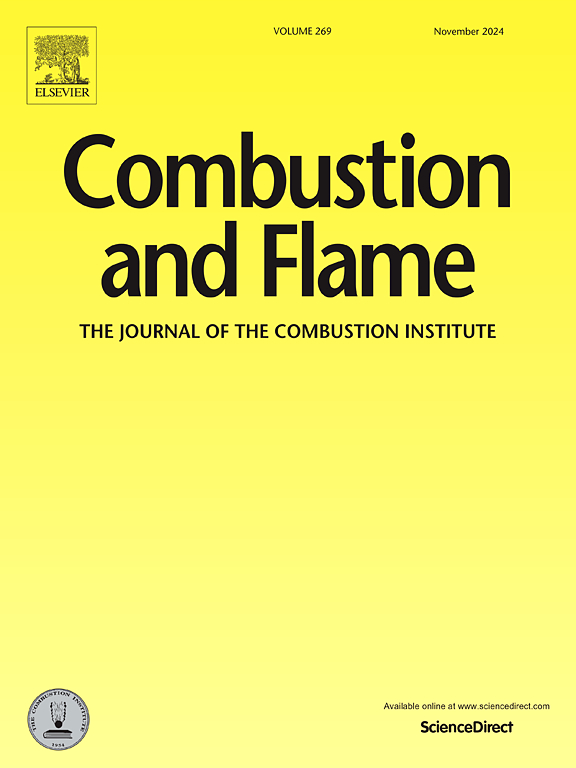A Fundamental investigation of the pyrolysis chemistry of oxymethylene ethers. Part II: Experiments and comprehensive model analysis
IF 5.8
2区 工程技术
Q2 ENERGY & FUELS
引用次数: 0
Abstract
Oxymethylene ethers (OMEs) form a high-potential family of synthetic chemicals to replace fossil-based fuels. These alternative liquid energy carriers can contribute to a circular carbon economy when synthesized through carbon capture and utilization technology using renewable electricity, so-called e-fuels. Despite the potential to significantly reduce greenhouse gas and particulate matter emissions and their favorable ignition characteristics, the radical decomposition chemistry of long-chain OMEs remains largely unexplored. Pyrolysis of small OMEs is well understood. Still, there is limited data available for long-chain OMEs, such as oxymethylene ether-3 (OME-3), oxymethylene ether-4 (OME-4), and oxymethylene ether-5 (OME-5). In this study, the pyrolysis of these long-chain OMEs is investigated by combined experimental and kinetic modeling work. Six new datasets are acquired from experimental units with tubular and jet-stirred reactors. The thermal decomposition is examined across a broad range of reaction conditions, which enables studying both the primary and secondary decomposition chemistry. At low temperatures, smaller OMEs and formaldehyde are the major decomposition products, whereas at high temperatures H2, CO, and methane become the dominant products. The yield of species with carbon-carbon bonds remains low. The kinetic model based on first principles from Part I, consisting solely of elementary reaction steps, is validated against the newly acquired experimental datasets. This new model outperforms literature models and predicts experimental trends of important products, on average, within the experimental uncertainty margin without fitting model parameters. Comprehensive model analysis by means of rate of production and sensitivity analyses indicates that formaldehyde elimination reactions, which yield smaller OMEs, dominate the thermal decomposition.
甲氧基醚热解化学的基础研究。第二部分:实验与综合模型分析
甲氧基醚(OMEs)是一类极具潜力的合成化学物质,可替代化石燃料。这些可替代的液体能源载体可以通过碳捕获和利用技术合成,利用可再生电力,即所谓的电子燃料,为循环碳经济做出贡献。尽管长链OMEs具有显著减少温室气体和颗粒物排放的潜力,并且具有良好的点火特性,但其自由基分解的化学性质在很大程度上仍未被探索。我们对小颗粒OMEs的热解过程有很好的了解。然而,关于长链线粒体的数据有限,如甲氧基醚-3 (OME-3)、甲氧基醚-4 (OME-4)和甲氧基醚-5 (OME-5)。本研究采用实验和动力学模拟相结合的方法研究了这些长链OMEs的热解过程。从管式和喷射搅拌反应器的实验装置中获得了六个新的数据集。热分解是在广泛的反应条件下进行研究的,这使得研究初级和次级分解化学成为可能。在低温下,较小的OMEs和甲醛是主要的分解产物,而在高温下,H2、CO和甲烷是主要的分解产物。具有碳-碳键的物种的产率仍然很低。基于第一部分第一原理的动力学模型,仅包括基本反应步骤,针对新获得的实验数据集进行了验证。该模型优于文献模型,在实验不确定性范围内平均预测重要产品的实验趋势,而无需拟合模型参数。通过产率分析和敏感性分析,综合模型分析表明,甲醛消除反应在热分解中占主导地位,产生较小的OMEs。
本文章由计算机程序翻译,如有差异,请以英文原文为准。
求助全文
约1分钟内获得全文
求助全文
来源期刊

Combustion and Flame
工程技术-工程:化工
CiteScore
9.50
自引率
20.50%
发文量
631
审稿时长
3.8 months
期刊介绍:
The mission of the journal is to publish high quality work from experimental, theoretical, and computational investigations on the fundamentals of combustion phenomena and closely allied matters. While submissions in all pertinent areas are welcomed, past and recent focus of the journal has been on:
Development and validation of reaction kinetics, reduction of reaction mechanisms and modeling of combustion systems, including:
Conventional, alternative and surrogate fuels;
Pollutants;
Particulate and aerosol formation and abatement;
Heterogeneous processes.
Experimental, theoretical, and computational studies of laminar and turbulent combustion phenomena, including:
Premixed and non-premixed flames;
Ignition and extinction phenomena;
Flame propagation;
Flame structure;
Instabilities and swirl;
Flame spread;
Multi-phase reactants.
Advances in diagnostic and computational methods in combustion, including:
Measurement and simulation of scalar and vector properties;
Novel techniques;
State-of-the art applications.
Fundamental investigations of combustion technologies and systems, including:
Internal combustion engines;
Gas turbines;
Small- and large-scale stationary combustion and power generation;
Catalytic combustion;
Combustion synthesis;
Combustion under extreme conditions;
New concepts.
 求助内容:
求助内容: 应助结果提醒方式:
应助结果提醒方式:


